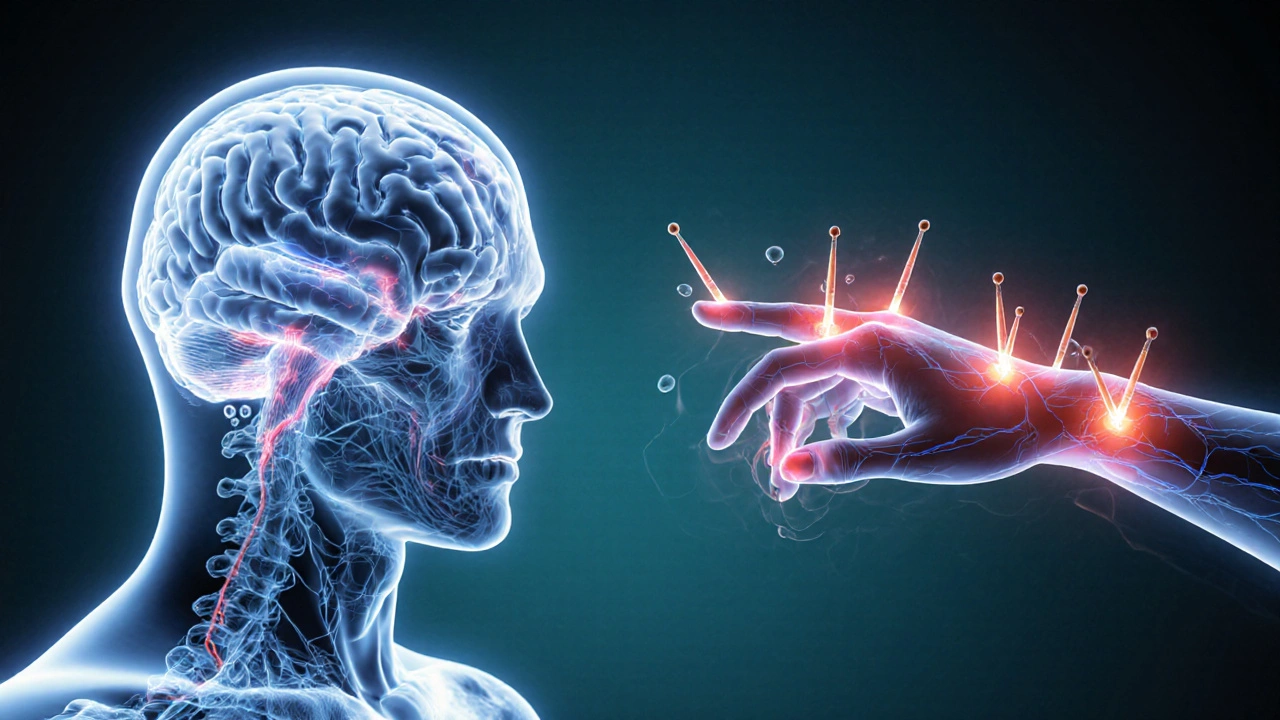When people hear Acupuncture is a needle‑based therapy originating from Traditional Chinese Medicine that aims to balance the body’s energy, or “Qi,” by stimulating specific points, they often wonder if it can calm the shaking that comes with tremor. The promise of a drug‑free option attracts anyone dealing with unwanted muscle movement, but does science back up the claim? This article breaks down what tremors are, how acupuncture is supposed to work, what the research says, and how to decide if it’s right for you.
Key Takeaways
- Acupuncture targets specific points to modulate nerve activity, which may reduce tremor amplitude in some patients.
- Evidence is mixed: small trials show modest benefits for essential tremor, while data for Parkinson’s‑related tremor are limited.
- Safety profile is strong when performed by licensed practitioners, but contraindications include bleeding disorders and certain skin infections.
- Integrating acupuncture with conventional medication can be effective, but it shouldn’t replace proven drugs without medical advice.
- Choosing a qualified practitioner and setting realistic expectations are crucial for any natural treatment.
What Exactly Is a Tremor?
A tremor is an involuntary, rhythmic shaking of a body part. It can affect the hands, head, voice, or even the entire body. The two most common types that drive people to seek alternative relief are essential tremor and the tremor caused by Parkinson's disease. Essential tremor usually shows up during purposeful movements-think of a coffee cup wobbling as you bring it to your mouth-while Parkinsonian tremor often appears at rest and may be accompanied by stiffness and slow movement.
Understanding the underlying cause matters because treatment strategies differ. Medications such as propranolol or primidone are first‑line for essential tremor, whereas dopaminergic drugs target Parkinson’s‑related shaking. When drugs fall short or cause side effects, patients start exploring natural options like acupuncture.
How Acupuncture Is Supposed to Work
Acupuncture belongs to the broader umbrella of Traditional Chinese Medicine (TCM). TCM views health as a balance of Qi-the vital life force that flows through pathways called meridians. By inserting ultra‑thin needles at specific acupuncture points, practitioners aim to unblock stagnant Qi, restore harmony, and ultimately calm nervous system over‑activity.
From a Western perspective, needle stimulation triggers the release of endogenous opioids, serotonin, and other neurotransmitters. These chemicals can modulate the brain’s motor circuits, potentially dampening the erratic firing that leads to tremor. Some researchers also suggest that acupuncture improves peripheral circulation, which may affect muscle tone and reduce shakiness.

What the Research Says
Clinical evidence for acupuncture’s effect on tremors is still emerging. A 2022 systematic review of nine randomized clinical trials involving 483 participants with essential tremor reported an average 15‑20% reduction in tremor severity scores when acupuncture was added to standard medication. However, the same review noted high variability in study quality, needle protocols, and outcome measures.
For Parkinson’s disease, the data pool is smaller. A modest 2021 pilot study in Japan compared 30 patients receiving weekly acupuncture for 12 weeks against a sham‑needle control. The acupuncture group showed a slight decline in Unified Parkinson’s Disease Rating Scale (UPDRS) tremor items (mean change-1.2 points) while the control group changed by only-0.4 points. Though statistically significant, the clinical relevance remains debated.
Placebo effects play a notable role in any intervention that involves patient expectations and therapist interaction. In acupuncture studies, sham‑needle designs often produce measurable improvements, underscoring the importance of practitioner‑patient rapport. Still, the fact that a subset of patients experiences tangible tremor reduction beyond the placebo baseline suggests a genuine physiological component.
Safety, Side Effects, and Contraindications
When performed by a licensed practitioner, acupuncture has a low risk profile. Common, mild side effects include transient bruising, soreness at needle sites, or a brief feeling of dizziness. Serious complications-such as infections or organ injury-are exceptionally rare (<0.01% incidence) but can occur if sterile technique is ignored.
People with bleeding disorders, those taking anticoagulants like warfarin, or individuals with skin infections at the insertion sites should avoid needle‑based treatment. Pregnant women are generally advised to skip points that could stimulate uterine contractions.
Before booking a session, ask the practitioner about their certification, infection control practices, and whether they follow the Safety guidelines set by the national acupuncture board.
Practical Guide: What to Expect From an Acupuncture Session
- Initial Consultation: The therapist will review your medical history, current medications, and specific tremor concerns. Expect a brief discussion of TCM concepts like Qi and meridian patterns.
- Point Selection: For tremor, common points include LI4 (Hegu), LI11 (Quchi), and LR3 (Taichong), which are believed to calm motor over‑activity. Additional points may target stress reduction (e.g., GV20) to address anxiety‑related shaking.
- Needle Insertion: Sterile, single‑use needles (typically 0.25mm diameter) are inserted to a depth of 0.5‑1cm for hand points, slightly deeper for larger muscles. Most patients feel only a faint tingling sensation.
- Retention Period: Needles remain in place for 20‑30minutes. During this time, the practitioner may gently manipulate the needles or apply mild electrical stimulation (electro‑acupuncture) to enhance the effect.
- Post‑Session Advice: Hydrate, avoid heavy meals, and note any changes in tremor intensity. Many clinics recommend a series of 6‑10 weekly sessions for measurable improvement.
Remember, acupuncture is a support tool, not a cure. Track your tremor severity using a simple rating scale (0=no tremor, 10=severe) before the first session and after each treatment to gauge progress.

Acupuncture vs. Conventional Medication: A Quick Comparison
| Aspect | Acupuncture | Standard Medication |
|---|---|---|
| Typical Effect Size | ~15‑20% reduction (study average) | 30‑50% reduction (beta‑blockers, primidone) |
| Onset of Benefit | 2‑4 weeks of regular sessions | Within days to weeks after dosage adjustment |
| Side‑Effect Profile | Minor bruising, soreness; rare infection | Dizziness, fatigue, low blood pressure, cognitive fog |
| Cost (per month) | AU$150‑300 (6‑10 sessions) | AU$30‑80 (generic prescription) |
| Interaction with Other Treatments | Generally complementary; minimal drug interaction | Potential drug‑drug interactions; requires monitoring |
Notice that the most compelling reason people try Acupuncture for tremors is the low side‑effect risk and the desire for a holistic approach. If medication alone isn’t cutting it or produces unwanted effects, adding acupuncture may tip the balance toward better daily function.
Frequently Asked Questions
Can acupuncture cure my tremor?
No. Acupuncture is best viewed as a supportive therapy that may lessen tremor intensity. It does not eliminate the underlying neurological cause.
How many sessions are needed to see results?
Most studies report noticeable improvement after 6‑8 weekly sessions. Continued maintenance (once a month) can help sustain benefits.
Is acupuncture safe if I’m already on tremor medication?
Generally yes. Acupuncture does not interact with beta‑blockers or primidone, but always discuss additions with your neurologist.
What should I look for in a qualified practitioner?
Seek a practitioner registered with the national acupuncture board, who uses sterile disposable needles and can provide a clear treatment plan tailored to tremor management.
Are there any contraindications I should be aware of?
Yes. Avoid acupuncture if you have bleeding disorders, are on high‑dose anticoagulants, have active skin infections at insertion sites, or are pregnant without prior medical clearance.
Next Steps and Troubleshooting
If you decide to give acupuncture a try, start by consulting your neurologist to confirm it won’t interfere with your current regimen. Then, locate a certified practitioner-many clinics list their credentials online or can be found through local health directories.
Track your tremor scores before each session. If after eight weeks you see no change or if the shaking worsens, reassess with your doctor; acupuncture may simply not be effective for your specific condition.
For those who experience only mild improvement, consider combining acupuncture with lifestyle tweaks that also calm the nervous system: regular aerobic exercise, adequate sleep, and stress‑reduction techniques like mindfulness.
Remember, every body reacts differently. The key is an evidence‑based approach, open communication with healthcare providers, and realistic expectations about what a natural therapy can achieve.


Marilyn Decalo
October 10, 2025 AT 20:08Oh sure, another "miracle" needle story-because nothing says scientific rigor like poking yourself with metal sticks while chanting about Qi. I’ve read the entire pile of half‑breed studies and they all whisper the same thing: minimal effect, massive hype. The drama around acupuncture is almost as loud as a reality TV showdown. If you’re hoping for a cure, better check your insurance, not your acupuncture chart.
Mary Louise Leonardo
October 10, 2025 AT 20:26They don’t want you to see the real data-big pharma funds the “research” so they can keep you buying pills. Too lazy to dig deeper? The truth is hidden behind a veil of shiny needles and dubious journals. Wake up, people.
Alex Bennett
October 10, 2025 AT 21:13When you look at tremor disorders, the first thing that comes to mind is the intricate dance between the brain’s motor circuits and the peripheral muscles that execute the moves. Acupuncture, with its roots in millennia‑old traditions, offers a curious lens through which we can examine neuro‑modulation without loading the system with synthetic chemicals. From a physiological standpoint, needle insertion stimulates A‑delta and C‑fibers, prompting the release of endorphins, serotonin, and even gamma‑aminobutyric acid, all of which play roles in dampening excessive neuronal firing. Some researchers argue that this cascade can subtly re‑balance the basal ganglia’s output, thereby reducing tremor amplitude. However, the magnitude of that effect is often dwarfed by the variability inherent in patient populations and study designs. In the systematic review cited, the average reduction hovered around 15‑20 %, which, while statistically significant, translates to a modest change in daily life for many sufferers. It’s also worth noting that the sham‑needle studies reveal a non‑trivial placebo component, reminding us that expectation and therapist interaction are powerful mediators of outcome. If you’re already on propranolol or levodopa, adding a few weekly acupuncture sessions might act as an adjunct, not a replacement, and could lessen medication side‑effects for some individuals. Safety, on the other hand, remains a strong point; serious adverse events are rare when the practitioner follows sterile technique and respects contraindications. The biggest hurdle, though, is access to qualified professionals-especially those who understand both the traditional meridian theory and contemporary neurophysiology. As with many integrative approaches, the key is realistic expectation: acupuncture may smooth the edges of tremor, but it rarely eradicates the underlying pathology. Patients should discuss the option with their neurologist to ensure coordinated care and to avoid any unintended interactions. Ultimately, the decision rests on personal preference, financial considerations, and the willingness to experiment within the bounds of evidence‑based medicine. So, while needles aren’t a silver bullet, they can be a useful tool in a broader therapeutic toolbox.
Mica Massenburg
October 10, 2025 AT 21:23Honestly, the whole thing feels like a covert experiment-who’s funding those clinics anyway? Even if there’s a faint physiological signal, it’s buried under layers of bureaucratic noise.
Sarah Brown
October 10, 2025 AT 21:33Let’s keep the focus on what matters: safety, qualified hands, and honest communication. If you’re curious, start with a reputable clinic and track your tremor scores objectively.
Max Canning
October 11, 2025 AT 19:26Yo, I tried a few sessions last month and actually felt my hands shake less during coffee runs-definitely worth a shot if you’re looking for a natural boost!
Nick Rogers
October 11, 2025 AT 19:35Acupuncture can be a helpful adjunct, but it isn’t a standalone cure.
Melissa Young
October 11, 2025 AT 19:43Look, the whole Qi‑stuff is just a buzzword overlay for neuro‑plasticity‑induced modulation. When you stimulate the dermal mechanoreceptors, you’re basically engaging the somatosensory feedback loop, which can recalibrate the motor cortex tonus. Bottom line: it’s not magic, it’s neuro‑engineering, plain and simple.
SHASHIKANT YADAV
October 12, 2025 AT 23:13Interesting read! 😊 The blend of traditional practice with modern research is something we should explore more. 🙏
Ryan Pitt
October 12, 2025 AT 23:21Great points, especially about setting realistic expectations. Keep tracking your progress and stay hopeful-you’ve got this!